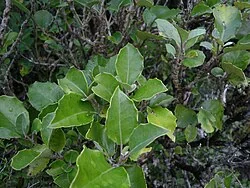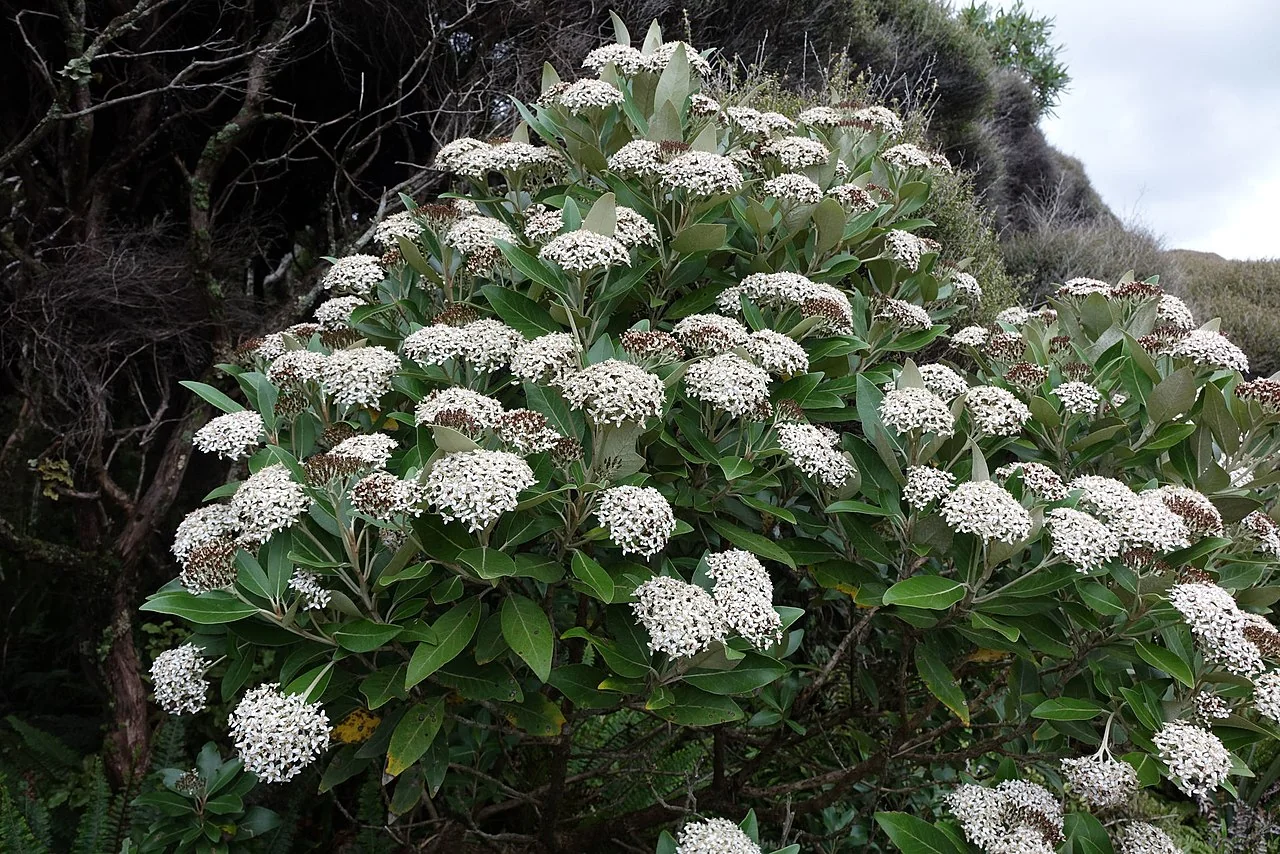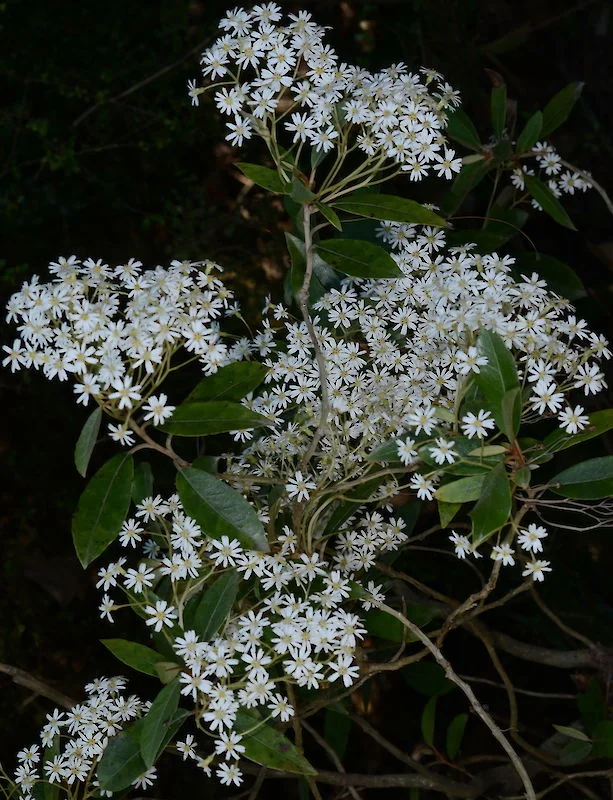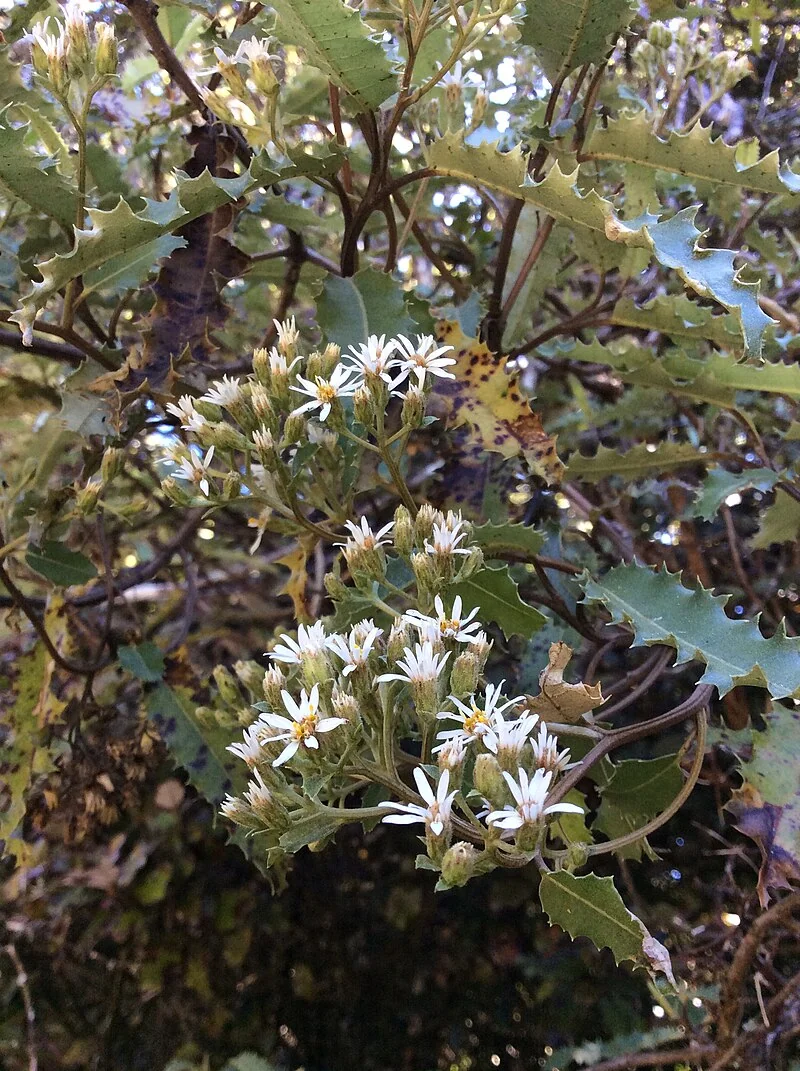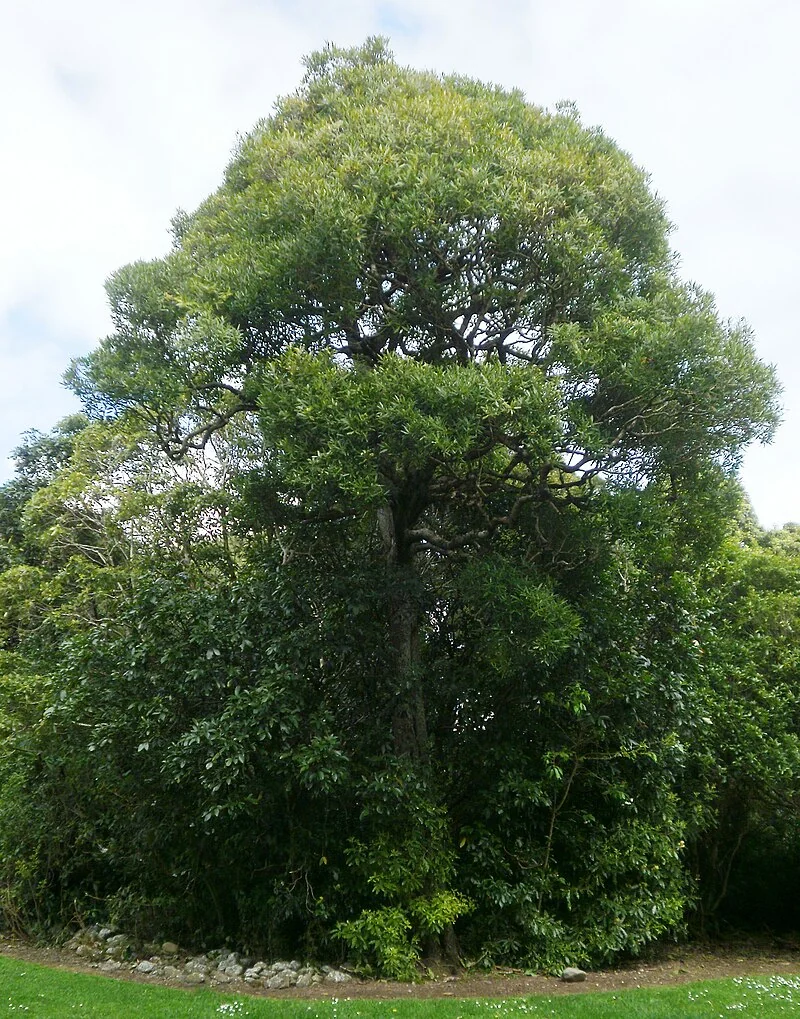
White Maire
Nestegis lanceolata
Introduction
About White Maire
Nestegis lanceolata, commonly known as White Maire, is an attractive medium-sized native tree distinguished by its elegant lance-shaped leaves and clusters of small, creamy-white flowers that appear in spring. This member of the olive family develops into a handsome specimen with smooth, grey bark and a rounded crown, producing dark purple drupes that provide crucial food for native birds including kereru and tui. Historically, White Maire was highly prized by Māori for its exceptionally hard, durable heartwood, which was carved into tools, weapons, and implements requiring strength and longevity. Today, this slow-growing but long-lived species is valued for ecological restoration and as an attractive specimen tree for temperate gardens where its distinctive foliage and bird-attracting fruits contribute to native biodiversity. Explore more in the native plants index.

Plant Description
Botanical Features
White Maire (Nestegis lanceolata) is an evergreen tree native to New Zealand, growing up to 15-20 meters high in its native environment, though it is often smaller in cultivation and can be multi-stemmed. It has a spread of over 8 meters. The tree features narrowly lance-shaped, leathery, dark green leaves that are similar to N. cunninghamii but smaller and narrower. The scientific name "lanceolata" refers to its lance-shaped leaves. It has pale, corky bark. Small, inconspicuous white flowers, 2-3 mm in diameter, are produced in clusters in the leaf axils or directly from the branches in late spring. These flowers are followed by green berries that ripen to orange or red. These fruits are attractive to birds, particularly the kereru.
Quick Facts
Overview
| Scientific Name | Nestegis lanceolata |
|---|---|
| Height | 8-15 m |
| Spread | 5-8 m |
| Water Needs | Low to moderate |
| Light | Full sun to partial shade |
| Frost Tolerance | Good |
| Salt Tolerance | Moderate |
| Growth Rate | Slow to moderate |
| Lifespan | Long-lived |
Climate Best Suited to
White maire grows in lowland to hilly forests of the North Island and northern South Island. It prefers warm, humid districts with well-drained soils and tolerates light frost inland once established.
Regional Suitability
| City | Climate Suitability |
|---|---|
| Whangārei | Ideal |
| Auckland | Ideal |
| Hamilton | Good |
| Tauranga | Ideal |
| Rotorua | Good |
| Gisborne | Good |
| New Plymouth | Good |
| Napier | Good |
| Whanganui | Good |
| Palmerston North | Moderate |
| Wellington | Moderate |
| Nelson | Poor |
| Christchurch | Poor |
| Dunedin | Poor |
| Invercargill | Poor |
Natural Habitat
White Maire is a native New Zealand tree found in lowland to lower montane forests across the North Island and in the northern parts of the South Island. It often grows on steep slopes, ridgelines, and in riparian areas, preferring well-drained soils. It is a resilient species, tolerant of drought once established, and can thrive in both full sun and partial shade.
Plant Conservation
Nestegis lanceolata, commonly known as white maire, is classified as "Not Threatened" in New Zealand. This conservation status was assigned in both the 2017 and 2012 assessments of the conservation status of New Zealand indigenous vascular plants. The species is endemic to New Zealand and is widespread and common in the North Island, though less common in the South Island. It typically grows in coastal to montane forests, often found on steep hill slopes, ridge lines, and riparian forests.
Growing Requirements
Soil Requirements
Prefers moist, free-draining loams enriched with organic matter. Avoid poor aeration and standing water. Mulch to build forest humus.
Light Requirements
Partial shade to full sun with shelter; full sun promotes denser crowns.
Water Requirements
Steady moisture during establishment; drought-tolerant later but benefits from deep watering in extended dry periods.
Planting Guide
1. Growing Conditions:
- Sunlight: White Maire thrives in full sun to partial shade.
- Soil: It prefers well-drained, moist soil that is rich in organic matter, with a pH between 5.5 and 7.5. It can tolerate clay and loam soils. Avoid waterlogged conditions to prevent root rot.
- Hardiness: Once established, Nestegis lanceolata is frost-hardy and tolerant of both coastal and inland conditions. It is rated H3 in the UK, meaning it's hardy in coastal and relatively mild parts, tolerating temperatures between -5 and 1°C.
- Exposure: It prefers a sheltered aspect.
2. Planting:
- When to Plant: The prime time for transplanting White Maire is from mid to late spring when growth is robust.
- Soil Preparation: When planting, enrich the soil with compost or other organic matter to promote strong root growth.
- Spacing: Allow at least 6-8 meters of space between trees to accommodate their mature size and canopy spread, as they can grow quite large.
Ecological Role
White maire (Nestegis lanceolata) is an evergreen component of coastal to lowland forests and dry hill country. Its fleshy fruits are eaten by kererū and other frugivorous birds, moving seed across fragmented habitats. The dense crown casts cool shade that buffers ground moisture and temperature, while durable wood and long life add persistent structure for epiphytes, lichens and cavity‑nesting fauna in mature stands.
- Seed dispersal: Bird‑transported drupes facilitate regeneration beyond parent trees.
- Microclimate: Evergreen canopy moderates extremes for understorey seedlings.
- Habitat longevity: Long‑lived stems host cryptogams and provide perches and shelter.
Uses and Significance
Dark purple drupes provide essential food for kererā, tāā, and other native birds, particularly valuable as they ripen during late summer when other food sources may be scarce. The dense evergreen crowns offer year-round shelter and nesting sites for small birds while creating important shade and habitat structure in forest margins and restoration plantings. The exceptionally durable timber contributes to long-term forest structure, with mature trees potentially living for centuries and providing stable habitat anchors in native ecosystems.
Cultural Notes
Historically valued for extremely hard timber; today a key restoration species and long-lived specimen.
Landscaping Ideas
Elegant Evergreen for Structure
- Specimen or avenue: Narrow, upright habit suits driveways and large lawns.
- Dry city sites: Once established, tolerates summer dryness; good for low-care plantings.
- Wildlife value: Flowers and fruit support insects and birds; underplant with drought-tolerant natives.
Provide sun to light shade and well-drained soils. Allow root space away from paving and services.
Seasonal Care Calendar
Spring
Plant and stake; weed control and mulching.
Summer
Deep watering in drought; check ties.
Autumn
Reduce irrigation; light tidy.
Winter
Structural/sanitation pruning on fine days.
Pruning and Maintenance
Techniques and Timing
Minimal pruning required beyond basic maintenance for this naturally well-formed tree. Maintain a single dominant leader during establishment years to develop good structure, then limit pruning to removal of dead, damaged, diseased, or crossing branches. Prune during winter dormancy to minimize stress and reduce sap bleeding. This slow-growing species responds poorly to heavy pruning, so focus on gentle shaping and sanitation cuts rather than major structural changes.
How to Grow White Maire
White Maire is an attractive medium-sized native tree distinguished by its elegant lance-shaped leaves and clusters of small, creamy-white flowers. This member of the olive family develops into a handsome specimen with smooth, grey bark and a rounded crown, producing dark purple drupes that provide crucial food for native birds. Historically, White Maire was highly prized by Māori for its exceptionally hard, durable heartwood. Today, this slow-growing but long-lived species is valued for ecological restoration and as an attractive specimen tree for temperate gardens. Understanding its propagation methods is key to successfully growing this important species.
From Seed
Propagating White Maire from fresh seed is a viable method, though it requires careful handling and specific conditions. Collect fresh seed from ripe purple drupes in late summer to autumn, removing flesh thoroughly before sowing to prevent fungal issues. Sow immediately in cool, consistently moist conditions as seed loses viability quickly when dried. Germination typically occurs within 4-8 weeks under optimal conditions of 15-18°C. Prick out seedlings very gently to avoid damaging the sensitive taproot system, handling only by the leaves rather than stems or roots. This method is crucial for maintaining genetic diversity and for large-scale restoration projects.
From Cuttings
Vegetative propagation of White Maire, particularly from cuttings, can be challenging with variable success rates. Occasional basal shoots or suckers can be carefully separated and potted when they develop their own root systems, typically in late winter or early spring. Semi-hardwood cuttings taken from current season's growth in late summer can root with rooting hormone and consistent mist propagation, though success rates are variable and this species is generally slow to establish from cuttings. Bottom heat and high humidity improve rooting success. This method is best suited for experienced propagators or for specific conservation efforts.
Pests and Diseases
Generally Low-Maintenance
- Root stress: Waterlogging leads to decline; choose free-draining sites.
- Scale/sooty mould: Treat with horticultural oil and improve airflow.
- Leaf scorch: Young plants may scorch in hot, dry winds; provide temporary shelter and mulch.
Feed lightly in spring; excessive fertiliser is unnecessary and can encourage soft, pest-prone growth.
Cultural Significance
Nestegis lanceolata, commonly known as White Maire, holds significant cultural importance, particularly in New Zealand.
Its cultural significance stems from several Aspects:
- Traditional Māori Use: Māori utilized the hard timber of White Maire to craft various implements and weapons. Additionally, the fruit of the tree was a food source for Māori.
- Ecological and Heritage Value: White Maire is recognized as a culturally significant species that contributes both ecological and heritage value within New Zealand.
- Native Restoration and Landscaping: The tree is highly valued in New Zealand for its role in native restoration projects, shelterbelts, and as a specimen tree in larger gardens and parks. It is an excellent choice for creating authentic and sustainable native plantings.
- Support for Native Birdlife: White Maire plays a crucial role in supporting native bird populations, especially the kererū, which feeds on its fruit and aids in seed dispersal.
Bonus Tip
White maire (Nestegis lanceolata) develops an attractive, durable timber and a deep root system. In urban sites, allow generous spacing from paths and services; roots will seek moisture. Plant with a moisture-wicking mulch rather than lawn up to the trunk to reduce mower damage and encourage steady growth.


